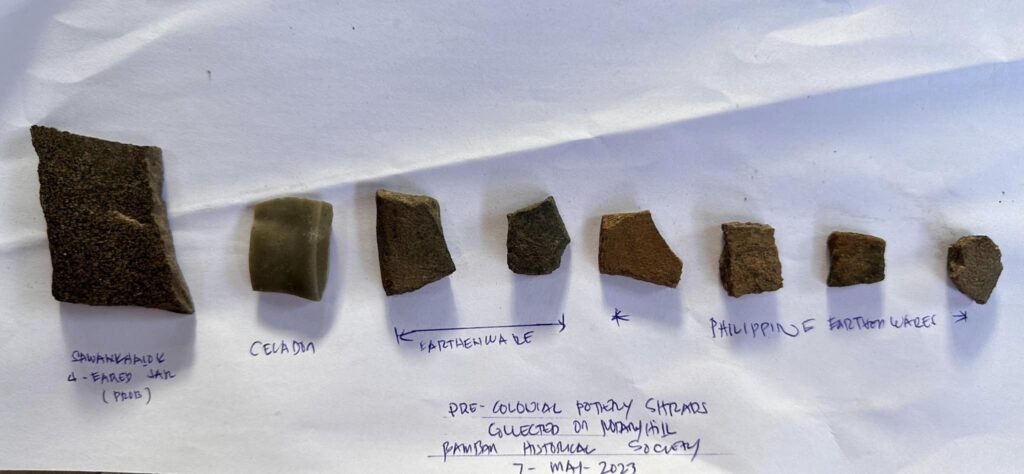
THE NEGRITOS (AYTAS) OF MT. PINATUBO
This article highlights the Aytas of Tarlac, Pampanga, and Zambales, accounts of the tribal wars and guerrilla operations in support of the USAFFE resistance movement and later in the ultimate combat victory of the American forces in 1945. From the verdant forested mountain areas of southwest and western Tarlac (Capas, Bamban and western Tarlac province), the northwest uplands of the Pampanga (Mabalacat, Angeles, Porac and Floridablanca) and the deep jungles Zambales mountains in San Marcelino (Aglao and Sawang), as the locations were in fact ancestral lands of the Ayta people where two American military facilities were actually established in the vicinity; the US naval base at Subic and Clark-Fort Stotsenburg. Mt. Pinatubo is located northeast of Subic Bay while Clark-Fort Stotsenburg to the east; the Aytas of this ancestral domain spoke the language of the Mag-Antsi Sambal.

Fort Stotsenburg was established in the aftermath of the Philippine-American War which was originally an Ayta settlement. In the Subic naval post that was also established after the previous war, the Aytas were found settled in the vicinity including the mountains to the northwest and the American navy personnel also developed friendship. Such ties with the Aytas evolved, and the Americans allowed the natives to visit the camps, making them as mountain guides, porters, and servants. In the 1920s, military personnel from Stotsenburg established several series of camps up to Mt. Pinatubo, in the heart of the Ayta domain, which include recreational facilities for families of officers and enlisted men. Even Bamban Hills to the west, with its river and tributaries were favorite hiking trails with many water pools, were also the domain of the Mag-Antsi. Far to the north in what is now part of Sta. Juliana, Capas, Tarlac, the Aytas also forged friendly ties with the American 26th Cavalry when they established a military camp. The last of the known Ayta leader before the outbreak of WWII was King Tomas of the Pinatubo area, his clan fearsome and recognized as headhunters.

OPERATIONS OF THE NEGRITO MOUNTAIN PATROL UNITS IN LUZON
In the history of the USAFFE resistance in Luzon and in the Philippines, the contribution of the loyal Negritos can never be sidelines or ignored. For in late January 1942, at the thick of the fighting in Bataan at the Abucay Line, members of the Aytas joined Lt. Col. Thorpe’s Guerillas, during the attack on Japanese convoy and then on their trek to Porac Mountains; providing much needed necessities, food, as mountain guides and protection. Without the contribution of these Aytas, the fate of the guerrilla resistance in Luzon might not have been succeeded since the crucial time frame of organizing the commands was at critical point with Lt. Col. Thorpe’s sojourn to Pinatubo headquarters. With the success of his journey in the territory of the Aytas, the Luzon Guerilla Forces was born, and from that nucleus, himself being considered as the Father of USAFFE Guerrilla Resistance, the war against the Japanese Occupation was carried on with the Aytas from their ancestral lands to the corners of the island. The seemingly shy aborigines, clad with only G-strings and armed with bow and arrow or at times with their Katana dagger that lived in the vast verdant forests, unmindful of the situations in the central plains but put their loyalty to the American guerillas that went to their ancestral lands, the following are the tactical units operated in the Central Luzon against the seemingly overwhelming enemy:

Resistance in Zambales Mountains: Sawang Mountain Patrol
The Ayta enclave of Sawang, along with that of Aglao, nestled in the valley between the mountains of Macarang, Mabolinog and Bitnung, south of Mt. Pinatubo. After the fall of Bataan, Lt. Col. Claude A. Thorpe and Capt. Ralph McGuire (Western Luzon Guerrilla Area), from their headquarters in Porac Mountains, proceeded to Sawang, San Marcelino, Zambales and begun organizing the Ayta warriors under the tribal chief Pan Melicia Suria. In May 1942, Capt. McGuire, under authority from Lt. Col. Thorpe, formalized the Sawang Mountain Patrol with Pan Melicia as commander. The Aytas of Sawang conducted tribal warfare against the Japanese with constant combat patrol on the mountain trails, conducting harassment and sabotage on Japanese patrols, maintaining guards and sentinels for the access of the mountain trails to other USAFFE guerrillas. Col. Gyles Merrill moved to Sawang with the loyal assistance and protection of Capt. Pan Melicia’s guerrilla outfit and the 2,000 Aytas living in the region. From the Sawang Headquarters, Col. Merrill commanded the Luzon Guerrilla Forces sectors in Zambales, Pampanga and south Tarlac, where the Ayta warriors also acted as message couriers to various LGF commands in the region through the intricate mountain trails. At the end of 1945, Pan Melicia’s Sawang Ayta warriors killed more than 500 enemies in the course of combat operations and the unit was considered the most effective in the region, at times conducting independent combat patrol deep in the mountains of Mabayabas to Aglao, Zambales Mountains killing many Japanese troops.
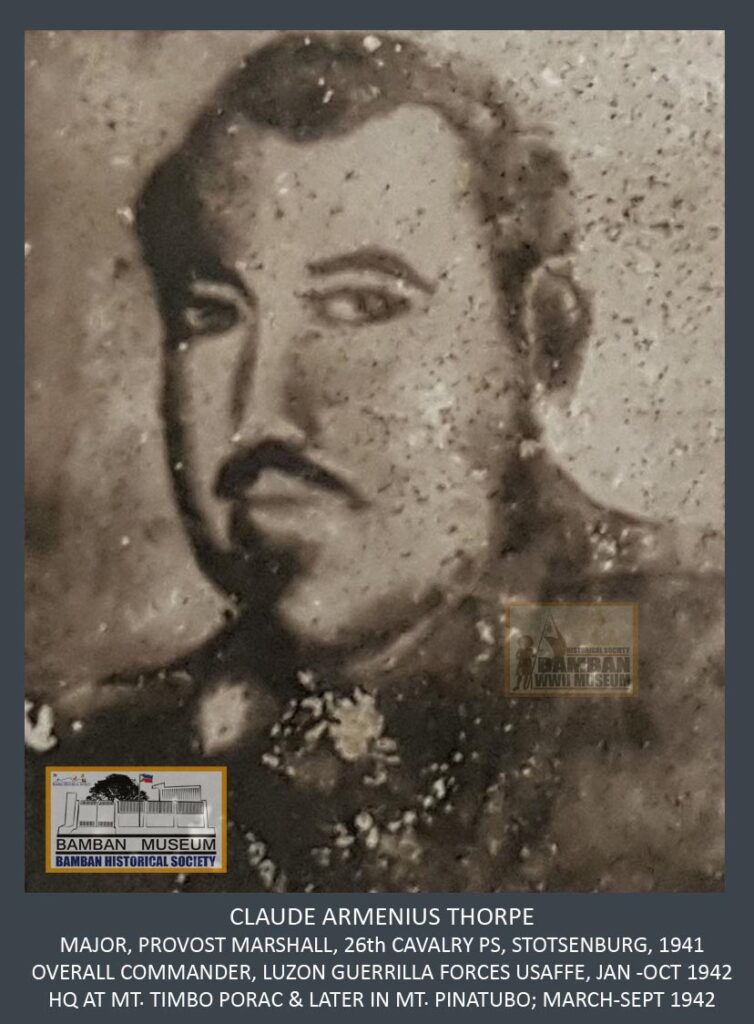
Conner’s Negrito Squadron 155: Guardians of the Pinatubo & Stotsenburg Reservation
South of Fort Stotsenburg, lies the ancestral domain of the Mag-Antsi tribes of the mountains of Porac, from the slopes of Banaba, to the series of hill-mas of Mt. Catuno, leading to Mt. Pinatubo to the north, the highest peak overlooking the American military bases. When Lt. Col. Thorpe reached the Ayta territory in March 1941, it was Eugenio Soliman, organized these Negrito clans into the service of the USAFFE guerrilla forces as mountain patrol unit, providing necessary supplies, shelters, guards and mountain couriers. In April 7, 1942 prior the fall of Bataan, Lt. Col. Thorpe inducted Major Soliman and the Ayta-Filipino guerrillas of Porac at Mt. Timbo headquarters, the heart of Ayta territory. Major Soliman’s command of Ayta warriors was designated as Squadron 55, himself appointed by Lt. Edwin Ramsey. On December 1, 1943, Lt. Henry C. Conner (28th Bomb Group) reorganized the Ayta guerrillas, designating it as Negrito Company, Squadron 155 Luzon Guerrilla Forces at Mt. Talbao, Porac. Lt. Eugenio Soliman became the commanding officer of the Negrito Company, while Ayta Kodiaro Laxamana became the local commander, with the tribal clan on each mountain district organized as platoon. The Negrito Company of Squadron 155 molded into an effective mountain patrol force, conducting intelligence, sabotage and as special guides. The primary mission was preventing the Japanese from utilizing the Pinatubo Trail; a mountain road network from Fort Stotsenburg, via Pinatubo crossing, and into Zambales shores to the west. Ayta Capt. Kodiaro Laxamana, with his Negrito Company comprising 238 men, was attached to the 108th, 185th Infantry Regiment 40th Division and later with the 149th Infantry Regiment 38th Division US Army in the combat operation against the Japanese army and navy forces of Clark, from late January 1945 till the June 1945, inflicting 500 enemy killed.

Squadron 30 (Negrito Mountain Patrol): Lookout Over Clark Field Area
The ancestral domain of the descendants of King Lucas, constituting the clans occupying the vicinity of Fort Stotsenburg including the mountains of Monikayo, Kalapi, Haduan, Kalan, the series of hill-mass of the Bamban and up to Betuen bordering Mt. Pinatubo were aware of the war that the Japanese would bring in their territory. When Lt. Col. Thorpe was on his way to the O’Donnell in September 1942, he met the able-bodied Aytas of Bamban and Mabalacat at Sitio Pindangan Damulag armed with bow and arrows and inducted them into the USAFFE guerrilla forces designating the command as Negrito Mountain Patrol under the leadership of Lt. Pedro Margarito. After the death of Thorpe in the latter part of 1943, Sgt. Alfred D. Bruce (12 MP Company, Philippine Scouts) accompanied by Capt. Wilbur J. Lage (adjutant to Lt. Col. Thorpe), and Corporal Rudolph O. Bolstad (A Co., 194th Tank Bn) and Lt. Jose Raagas (24th F.A. PS) took over the mountain patrol command, reorganizing the Aytas under Lt. Margarito and re-designating them as Squadron 30, South Tarlac Military District – Luzon Guerilla Forces with headquarters at Mataba Mountain in Bamban. Lt. Margarito’s Squadron 30 actively participate in the campaign with the American 40th, 43rd, 38th and 6th Divisions US Army against the Japanese forces at Clark-Bamban area known as Kembu Group. Several American downed naval aviators were rescued by the Aeta Negritos of Squadron 30, including Lieutenant Francis Grassbaugh (USS Wasp) and Ensign Allen J. Stover (VF-19, USS Wasp).
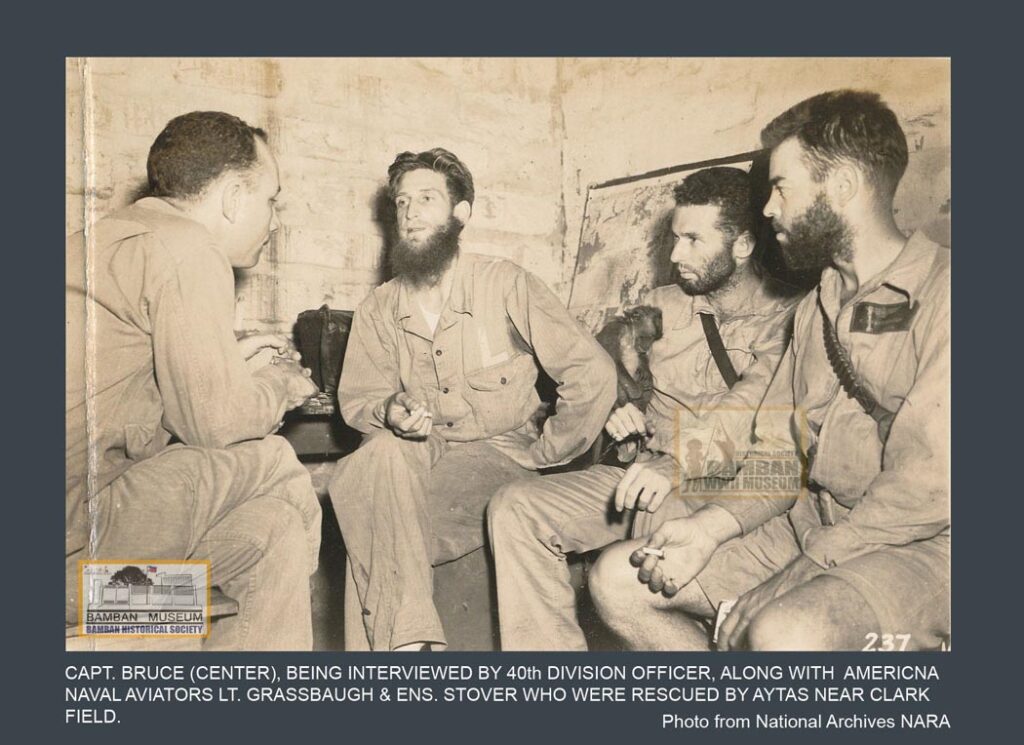
Biniayan Company: Guardians of Headquarters of Capt. Bruce
One of the trusted field commanders of Capt. Bruce in the mountains of south Tarlac, Captain Natalio Benedicto served with distinction as a sergeant in the US Army’s elite Philippine Scouts before the outbreak of WWII. In 1943, he would have utilized his skill he got from the Philippine Scout to command the elite group of Ayta warriors with some Filipinos to guard the headquarter mountain of south Tarlac. In the ancestral domain and territory north of Bamban, with the concertation of Japanese troops at the former Camp O’Donnell and the barrio of O’Donnell (Patling) as an important mountain pass also settled by the Indigenous People, the mountain community of Mt. Biniayan was an important convergence of mountain trails that later became the message center for the Luzon Guerilla Forces units in the lowlands of south Tarlac and the north with the headquarters of Capt. Bruce (Malasa Mountain, Bamban), Capt. Conner (Banaba, Timbo mountains, Porac) and Co. Merrill in Sawang Mountains. In the latter part of 1942, Lt. Col. Thorpe, on his journey to O’Donnell mountains, passed by the Biniayan and organized the Aytas into the fold of guerrilla mountain patrol led by Philippine Scout Eugenio Vistan (12th Ordnance Company, P.S.) comprising an original strength of 34 men. In December 1944, Vistan was killed and the command was given to Capt. Natalio Benedicto, also a former survivor of the Battle of Bataan. A total of 150 officers and men of these Indigenous People were formed the Biniayan Company (attached to Negrito Squadron 30 and later with the 1st O’Donnell Regiment) South Tarlac Military District Luzon Guerrilla Forces, as designated by Capt. Bruce when he took over the command of USAFFE guerrillas in the region in August 1944. With the coming of the American forces in Biniayan-O’Donnell area in late January 1944, the Ayta Biniayan Company became active in assisting combat operations in their mountain territory and acting as guides and patrol. All of the officers and members of the Biniayan mountain patrol were recognized by the US Army and officially attached to the Philippine Army on February 4, 1945.

Mountain Snipers: The Special Troop (Non-Christian) – 1st O’Donnell (Capas) Regiment
In the mountains of O’Donnell, part of the series of hill-mass south of Tarlac in the Ayta settlement of Sta. Juliana and barrio of O’Donnell, the Ayta Aberling and Ayta Mag-Antsi tribes settled in this rich valley since time immemorial. In May 1942, as the last Filipino-American main defense collapsed in Fortress Corregidor, a band of Ayta Mag-Antsi and Aberling warriors occupying the ancestral lands of O’Donnell and Sta. Juliana areas led by Alejandro Capit, Felix Austria, Macario Gutierrez, Pan Capuan, Dairit Laxamana and Pan Mata sworn to support the remnants of the USAFFE forces that comes to their territory including American escapees and Filipino survivors of Bataan Campaign and to fight as guerrillas against common enemy. Numbering more than a hundred mountain patrol, the Ayta guerrillas designated as Special Troops (Non-Christian) was attached to Squadron 4 under Captain Benedicto with the overall the command of Commander Gerundo Tapulayan of the Tarlac IV District. Their primary missions were typical of the Negrito mountain patrol units in the Luzon Guerrilla Forces of Zambales, Pampanga, and that of south Tarlac, acting as guides, security, conducting sabotage, intelligence, and message couriers and armed with their usual tribal weapons: the bow with poison arrows and Katana long dagger. The Ayta Special Troops was already organized when Lt. Col. Thorpe and his command sojourned to Sta. Juliana-O’Donnell ancestral domain that comprised then American military reservation in early October 1942, in which they provided the necessary troops as mountain guides, patrol, and security in the whole duration of his stay before his capture on the 29th. After the death of Lt. Col. Thorpe in 1943, Capt. Bruce took over the command of all USAFFE guerrillas of south Tarlac, including the Special Troops and attached all units of the area to the Luzon Guerrilla Forces led by Col. Merrill holed in the tribal territory of Sawang district south of Pinatubo in Zambales. With the coming of the American liberating forces in Capas-O’Donnell area, the Negrito Special Troops participated in the Battle of Capaya on January 26, 1945 and participated in the clearing operations in the mountains as attached to the following American infantry forces operating in their ancestral domain: 40th Recon Troops, 40th Division, 43rd Mechanized Cavalry Troops, 43rd Division, 149th Infantry Regiment, 38th Division US Army. In spite of its remarkable record, unfortunately, this Aeta unit was not recognized by the U.S. Army.

The Baluga (Negrito) Scouts – Tarlac West Sector, Lapham’s Guerrillas
In the western mountainous areas of Tarlac, Tarlac comprising the barrio of Sula, Maamot, and the O’Donnell-Moriones trail, the Ayta Aberling tribes occupied these ancestral territories a sub-group of the original Negritos of Mt. Pinatubo. These Aytas of western Tarlac where relatives to the Aberling of the O-Donnell – Sta. Juliana valleys and were also dispose in the USAFFE guerrilla resistance movement. By 1945, when the American forces begun to move on these mountain territories of the Indigenous People, the Aberling tribes concentrated in vicinity of Sula and Maamot bonded together to form bands of mountain patrol in support of the American operations in their area. Lt. Andres Dela Cruz, one of the tribal chiefs of the Aberling of western Tarlac, commanded the group and was designated as Baluga Negrito Scouts – Tarlac Military Area (Luzon Guerrilla Army Forces LGAF). Lt. Dela Cruz and his Ayta warriors were attached to Squadron 400-A, reporting to Maj. Albert Hendrickson of the Tarlac Military Area with Maj. Cris Hipolito as Filipino organizer and Intelligence Officer. Operations of Lt. Dela Cruz unit was activated during the clearing of the Ayta territory west of Tarlac, as their area, constituting mountain pass of the O’Donnell – Moriones – Sula trails in conjunction with the operations of the US Army 632nd Tank Battalion and 38th Division along with the Tarlac Military Area from late January to July 1945. Armed with bow and arrows and some with rifles, Lt. Dela Cruz mountain patrol engaged many of the Japanese escapees of the Battle of Bamban Hills and O’Donnell who were retreating to the north, to include elements of the Japanese Kembu Group (Takayama Detachment, Imperial Japanese Navy Setsueitai labor and construction units and the Taiwanese Murayama Butai). Although operating under Major Hipolito, Lt. Dela Cruz Baluga Scouts were not recognized by the U.S. Army. A similar name Andres Dela Cruz was reportedly implicated in the capture of Lt. Col. Claude A. Thorpe in September 1943 in the forest of western Tarlac.

EPILOGUE
These Indigenous People of Mt. Pinatubo areas proved their distinct heroism when they were organized as mountain patrol units operating around the military facilities in Subic and that of Clark-Stotsenburg. There was no doubt in the role these mountain people played in the success of the American war effort and liberation, albeit there were also Ayta tribes that were not fully documented and were not processed for recognition particularly the Aytas of Bataan, who were utilized from the early days of the Bataan Campaign by the USAFFE forces. Or the Baluga (Negritoes) Scouts of the Ayta Aberling tribes in western Tarlac, who were in the service of Capt. Albert Hendrickson’s Tarlac Military Area as mountain patrol, killing and capturing many of the Japanese stragglers that come out from the Bamban-O’Donnell battlefield. Their loyal services to the American war effort were never recognize after the war. Many of the former American guerrillas spoke highly of these Ayta guerrillas. And America’s respect to these Negrito USAFFE guerrillas of WWII continued after the war. Kodiaro Laxamana, a former commander of Negrito Company Squadron 155, was recognized by the US Air Force and bestowed the rank of colonel and was buried at the Clark Veterans Cemetery in 1970; a fitting tribute and reminder for the WWII campaign that these Indigenous People had served with utmost loyalty.
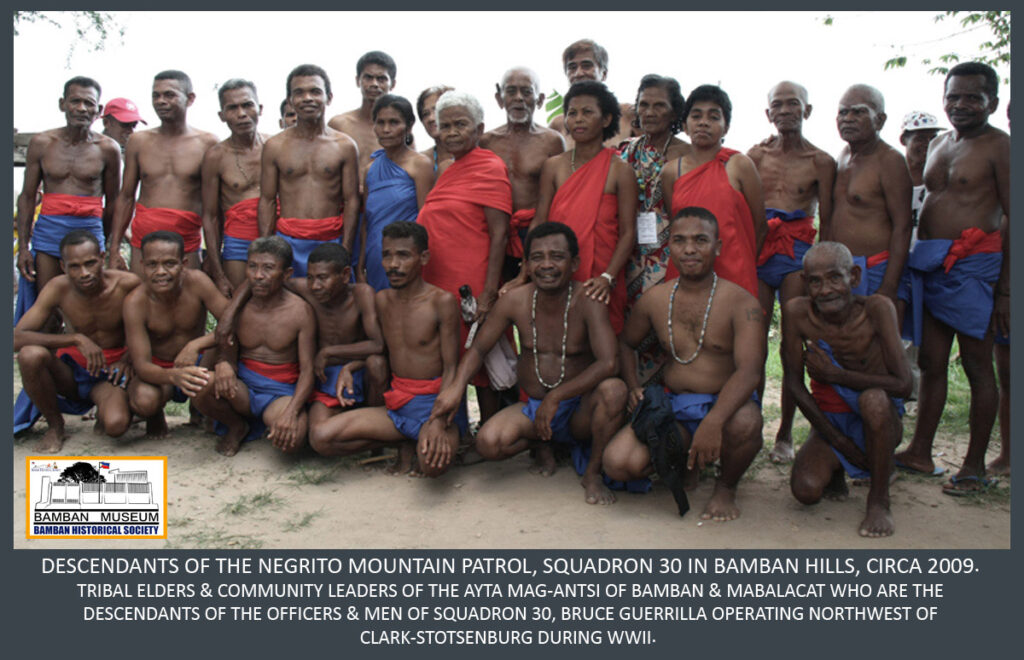
Most of the units of the Aeta Negrito mountain patrol units were recognized by the U.S. Army, with the exception of the Baluga Scouts of Tarlac Military Area and the Special Troop of the O’Donnell Regiment. There were also dark pages in history of WWII, where there were reported involvement of the Aetas in the killings of American guerrilla officers, particularly Capt. McGuire in Zambales, and Lt. Colonel Thorpe in western Tarlac. Nevertheless, their heroic role and contributions in the overall war effort should not be forgotten.
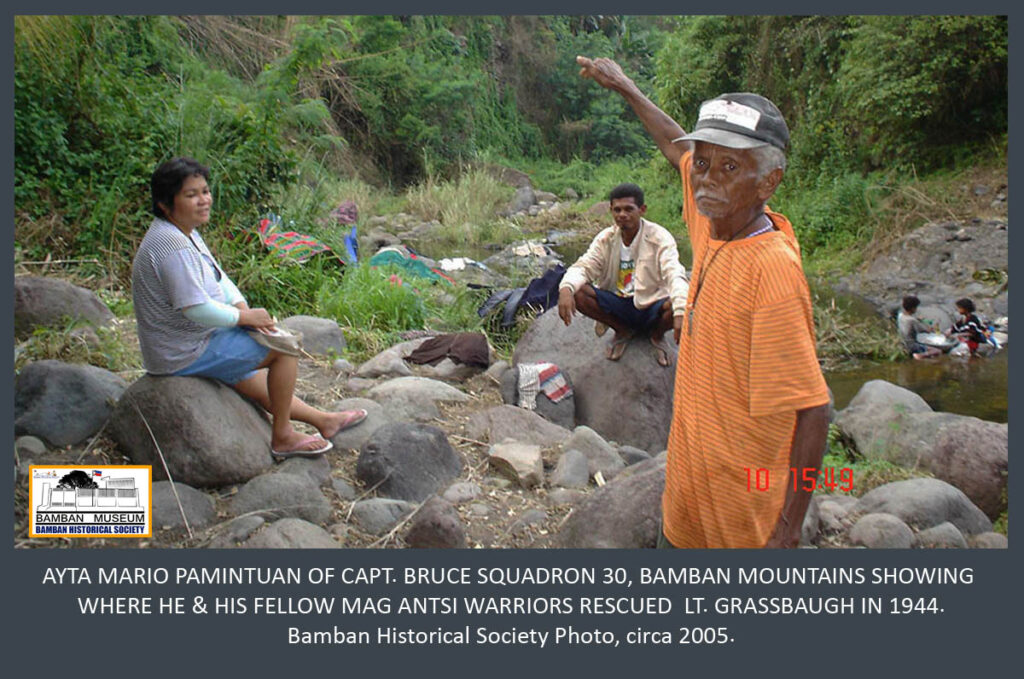
After the war, only a few of these loyal Aetas from Sawang, Squadron 155 and Squadron 30 were able to receive old age pension from the Government. In the town of Bamban, located 100 kilometers north of Manila and in the proximity of Clark Field, a special exhibit is dedicated to these mountain patrol, a reminder of their forgotten duty they held up high in their sacred mountain abodes.

Rhonie C. Dela Cruz
Bamban Historical Society
Bamban WWII Museum
November 20, 2024
SOURCES:
Philippine Archives Collection
Philippine Archives Collection – PVAO. http://collections.pvao.mil.ph/Guerilla/Collections.
-1st O’Donnell Regt, Southern Tarlac Military District, Luzon Guerrilla Forces.
– Biniayan Company, Southern Tarlac Military District (STMD), Luzon Guerrilla Forces.
– Bruce Guerrillas South Tarlac Military District.
– Colonel Claude A. Thorpe.
– Headquarters, Zambales Military District LGAF.
– Hipolito, Crisencio. “Patrol Report of G-2 Tarlac Military Area HQ May 25, 1945”, HQ Tarlac Military Area Luzon Guerrilla Army Forces.
– HQ Tarlac Military Area TMA Luzon Guerrilla Army Forces LGAF.
– Merrill, Gyles. Correspondence of Luzon Guerrilla Forces 1943-1945.
– Sawang Mountain Troops, Zambales Military District (ZMD).
– Squadron 155, Luzon Guerrilla Forces (LGF).
– Squadron 30 (Negrito) Southern Tarlac Military District (STMD).
Malcolm Decker, From Bataan to Safety: The Rescue of 104 American Soldiers in the Philippines.
David Sears, Warfare History Network “Alex Vraciu: U.S. Navy Ace, Philippines Guerrilla”, https://warfarehistorynetwork.com/article/alex-vraciu-u-s-navy-ace-philippines-guerrilla/, Accessed on July 12, 2023.
PHOTOS:
(a) Aytas near Fort Stotsenburg, pre-war.
*Credit to owner of the photo/image.
(b) Aytas of Olongapo near Subic, early 1900s.
Earl Ellis Collection.
(c) Aytas with American personnel in Bataan, early 1942.
Heroes of Bataan, Corregidor and Northern Luzon (Marcus Griffin and Eva Mane Matson)
(d) Portrait/sketch of Lt. Col. Claude A. Thorpe.
Bamban Museum Collection.
(e) 2nd Lt. Henry Clay Conner, later in command of the Squadron 155, pre-war.
Malcolm Decker, On a Mountainside.
(f) Capt. Bruce, with the rescued US Navy pilots taken in February 1945.
US National Archives NARA photo.
(g) Ayta warriors, armed with rifles probably from Sawang Mountain Patrol, attached to the 38th Division during operations in Zambales, circa 1945.
*Credit to owner of the photo/image.
(h) Ayta warriors with American personnel, circa 1945.
Courtesy of Ged Dizon.
(i) Edgar Wright with his Ayta scouts, taken near Olongapo, circa 1945.
Chris Schaefer, Bataan Diary.
(j) Kodiaro Laxamana (center), commander of Negrito Company, 155 Squadron with other Ayta guerrillas from Bamban, taken near Clark Field in early 1950s.
Time-Life photo.
(k) Descendants of Squadron 30, Bruce Guerrilla, Bamban Hills circa 2009. Rhonie Dela Cruz photo.
(l) Mario Pamintuan, formerly of the Squadron 30 near Baldugan Tandus, Bamban Hills, showing the location where an American naval aviator was rescued by his unit in late 1944. Rhonie Dela Cruz photo.
(m) Marshall Skiff, formerly with the 151st Infantry, 38th Division with descendants of Squadron 30 in Bamban, circa 2005. Rhonie Dela Cruz photo.

